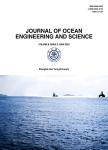Application of SWAN model for storm generated wave simulation in the Canadian Beaufort Sea
作者机构:Natural Resources CanadaBedford Institute of OceanographyDartmouthNova Scotia B2Y 4A2Canada Fisheries and Ocean CanadaBedford Institute of OceanographyDartmouthNova Scotia B2Y 4A2Canada
出 版 物:《Journal of Ocean Engineering and Science》 (海洋工程与科学(英文))
年 卷 期:2020年第5卷第1期
页 面:19-34页
核心收录:
学科分类:0710[理学-生物学] 0830[工学-环境科学与工程(可授工学、理学、农学学位)] 07[理学] 0908[农学-水产] 0707[理学-海洋科学] 0815[工学-水利工程] 0824[工学-船舶与海洋工程]
基 金:Geological Survey of Canada Contribution no-20090016.
主 题:Arctic Ocean Beaufort Sea Mackenzie delta Storm waves SWAN.
摘 要:The wave model SWAN(Simulating WAves Nearshore)is implemented for the Canadian Beaufort Sea and storm generated waves are investigated through comparisons between in situ buoy observations and numerical simulations.Simulations are performed for four storms using the SWAN wave model.We specifically use SWAN’s non-stationary and two-dimensional modes in a fine resolution nested domain within a coarse resolution domain.Two established whitecapping formulations in SWAN are examined;one is dependent on mean spectral wave steepness and the other is on local spectral steepness.Model simulations in the shallow fine resolution domain also consider the effects of bottom friction and nonlinear triad interactions.For the Beaufort Sea study area,wave simulations in which the white capping formulation is dependent on local spectral steepness are better than those where the dependency is on mean spectral steepness;however implementation of bottom friction term and triad mechanisms in the present study does not lead to any notable enhancement in the simulations.



